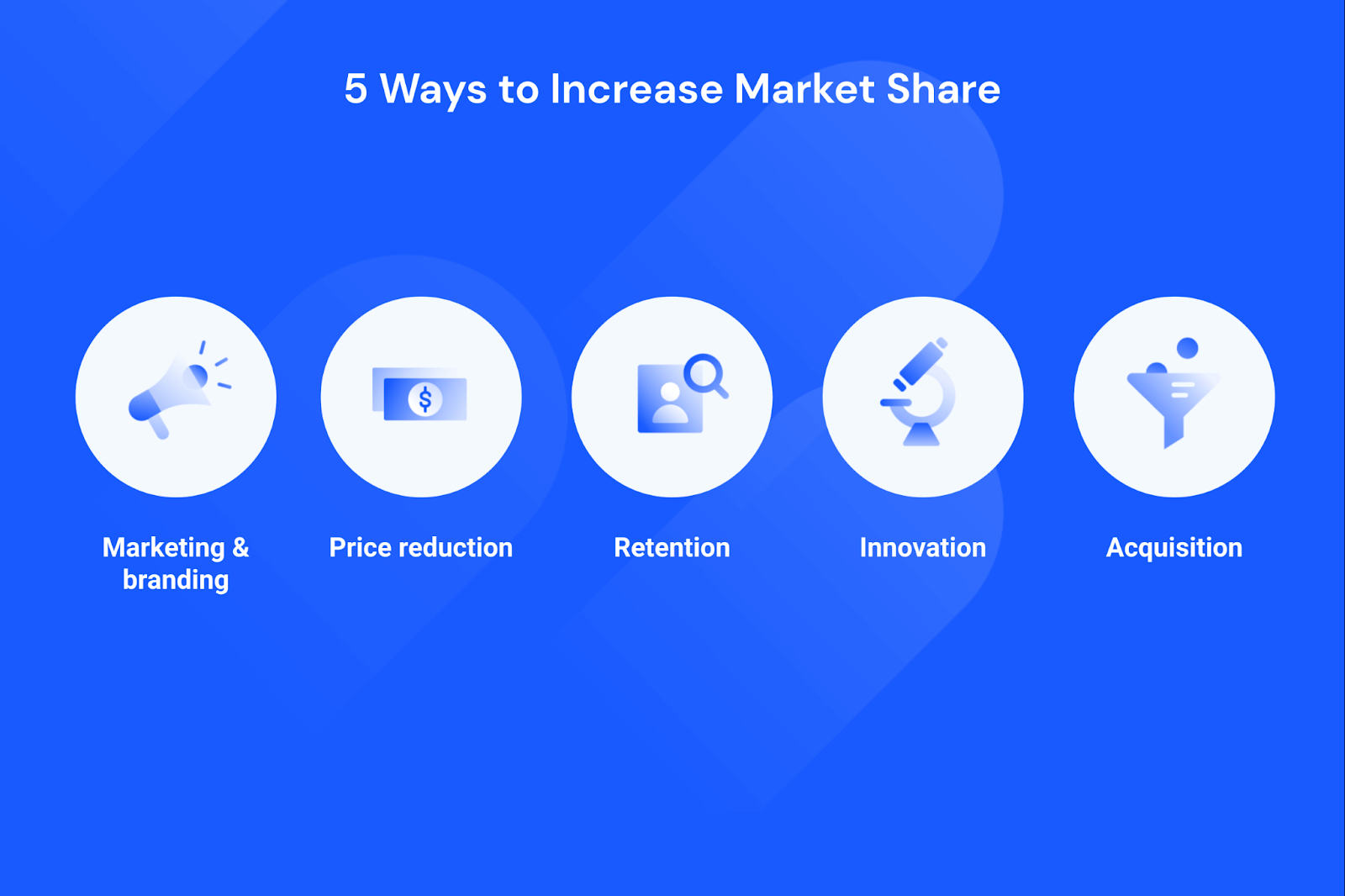What is Market Share: Definition, Formulas, and Examples

Market Share represents the success of a business in cold hard numbers.
Knowing what it is and how to measure it can help a business benchmark performance, track success, and make plans to grow.
What is market share?
Market share is a company’s percentage of the overall sales in a given industry or market.
Why is market share important?
Market share is the ultimate measure of a company’s success within its market. It’s calculated using sales revenue, not profit. Knowing how you stack up against rivals is a solid indicator that can be used for competitive benchmarking, identifying industry leaders, strategic planning, and much more.
Why do you need to grow your market share?
Market share is usually assessed over a fiscal year or quarter. Monitoring it helps evaluate your company’s growth by examining how you progress relative to the overall market growth. A thriving company will see its market share increase faster than that of the competition.
Any tiny shift in the market distribution in stable markets can disrupt well-balanced market forces. In growth markets, changes are expected and, therefore, less significant. With new products or technology, a vendor could bite off a competitor’s share or attract a new target audience that wasn’t previously part of the equation.
However dynamic your market, increasing your industry share is vital for growth. Capturing a larger percentage of the market means you are increasing sales and revenue.
How do you calculate market share?
There are many ways to establish market share, and finding the right method for your business is important. It can be gained or taken quickly, so companies must use Digital Intelligence tools like Similarweb to keep track of key market share metrics in real time. Simply using revenue figures alone is no longer enough to keep up with the speed of change that most markets are experiencing.
Market share formula by revenue
Take your total annual revenue figure, divide it by the total overall revenue for your market, and then multiply it by 100 to get the percentage. For example, if your annual revenue is $1M, and the total revenue for your market is $100M, then you have a 1% share of the market.
Relative market share formula
You may want to compare your business to a specific competitor or industry leader. In this case, you can calculate the relative market share. Divide your market share by that of the relevant rival.
Read more in our full guide to market share formulas – Expand Your Reach: 4 Market Share Formulas to Get You There
Analyzing your market share
The company with the largest market share is usually considered the industry leader. But market share is no key indicator of a company’s financial health, profitability, or growth. It measures your competitiveness and gives you a general idea of how you match up in your target arena.
What does market share mean for your position in the competitive environment? It shows how the pie is sliced and how big a piece you have relative to everyone else. When you segment your target market, you receive a more granulated view. Picture each segment as a whole pie and compare how the distribution of portions varies.
Digital companies often use traffic share to gauge their control of the online “pie.” This is particularly valuable if you are running a non-ecommerce site and can’t measure your percentage based on revenue. Measure your traffic share and segment it as you would the market. Take a look at the example in the following section to see how it’s done.
Understanding your market share
Market share is also relative to your business. A global market share of 1% is nothing to brag about for a company that sells to the worldwide market. But if you only target Texas, it’s an impressive number, and you might even be leading the local market.
As a local vendor, you should consider benchmarking against comparable businesses in other regions. Choose similar size companies with equivalent audience demographics. This lets you evaluate if your market share is average for your type of company or exceptionally high or low.
To gauge market share correctly, look at your target audience segment. Your company may focus primarily on women, millennials, or high-income customers, which means your goal is leadership in a particular market segment. You’ll conquer the rest later with a new strategy.
The bottom line; when you try to gain insights from market share, make sure to view it in the proper context.
Market share example
Another way to calculate market share is to use website traffic as your key performance indicator. This way, you get a benchmark you can track in real-time, and while it’s not revenue-based, it shows how much interest and activity takes place in a market and allows you to track known industry leaders and your own site efficiently and easily.
Here’s a faster, more modern approach to measuring your share of the market. In this example, I’m using the accommodation and hotel market to demonstrate how to quickly analyze market share.
In 30 seconds, I can see who the industry leaders are and by what percent their business has grown or declined in a given period. I also see rising players; this is interesting, as these companies show notable growth in my market. So, while they have a relatively low share right now, they are emerging names with the ability to disrupt a market fast. At the bottom of the market leaders page, I can see a list of market leaders, sorted by share of traffic, with other useful traffic and engagement metrics to track, along with a yearly change %. This covers the top 10k domains in a sector, so it’s extensive and comprehensive.
You’ll have noticed a market quadrant analysis too. A quick click downloads a nice visual representation of the market leaders; which you can filter and sort according to the market share metrics that matter to you most. In this example, I chose unique visitors and traffic share.
5 ways to increase market share
- Marketing and branding
With more aggressive advertising, you can expand your reach, gain more users, and increase customer loyalty. For long-term effectiveness, a strong branding strategy is essential. - Price reduction
You can tackle the issue from another angle by lowering your pricing just enough to beat the competition. This is the idea behind periodic discount campaigns, in which companies manage to steal competitors’ customers before raising prices again. - Retention
Nurturing your existing customer base is an underutilized and highly effective method. You keep your customers close when you maintain a positive relationship and send an occasional special offer. - Innovation
The best example of this strategy is Apple. The company constantly and regularly offers new product lines and innovative features for its existing products. Customers keep coming back for more. - Acquisition
If you can’t beat them, buy them. One way that helps Facebook to expand is by acquiring smaller companies and taking over their market share. Instead of winning over new customers, they take over the company.
Drawing conclusions from market analysis
Let’s look at an example of a non-ecommerce digital competitive set and the insights we gain from looking at market share.
Take the news site cnn.com. To define the target market, we look at the overall traffic to publishers and media sites. Specifically in the U.S., CNN’s traffic share is roughly 12%, putting them in second place right after Yahoo, also the global leader.
On the other hand, the news channel ranks number 85 globally. Does this mean CNN isn’t a significant news channel? Not necessarily. We can learn two things: Americans are the largest segment of news consumers, and CNN successfully targets American readers. We can also analyze traffic segments, such as specific marketing channels or devices, to learn more.
The next step
Similarweb Digital Research Intelligence is THE go-to platform for accurate traffic trend data. Compared to other market analysis tools, it provides the freshest insights, packaged in an intuitive platform that highlights the important changes and market share metrics you need to track.
Why Similarweb
- Data you can depend on
- Dynamically updates to give daily insights
- Easy-to-use platform, filled with useful market intelligence
- Highly accurate market trends data
- Try it for free and find out where your market stands.
FAQ
How can I measure market share growth?
Calculate market growth by subtracting the market size for year one from the market size for year two. Divide the result by the market size for year one and multiply by 100 to convert it to a percentage.
What is the market share formula?
Divide your business revenue (traffic) by the total industry revenue (traffic). The result is your market share.
What is the quickest way to calculate market share?
Use a digital intelligence platform to capture real-time market share data. Outdated methods that rely on revenue alone fail to give you a current view of industry leaders.
How can you increase your market share?
Increase market share by using marketing and branding, price reduction, retention, innovation, and acquisition.
Track your digital metrics and grow market share
Contact us to set up a call with a market research specialist

















